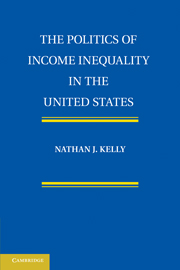Book contents
- Frontmatter
- Contents
- List of Figures
- List of Tables
- Acknowledgments
- 1 Explaining Income Inequality
- 2 The Distributional Force of Government
- 3 Political Conflict over “Who Gets What?”
- 4 Party Dynamics and Income Inequality
- 5 Macro Policy and Distributional Processes
- 6 Putting the Pieces Together: Who Gets What and How
- 7 Distribution, Redistribution, and the Future of American Politics
- Appendix A Congressional Questionnaire
- Appendix B Measuring Income Inequality over Time
- Bibliography
- Index
2 - The Distributional Force of Government
Published online by Cambridge University Press: 24 October 2009
- Frontmatter
- Contents
- List of Figures
- List of Tables
- Acknowledgments
- 1 Explaining Income Inequality
- 2 The Distributional Force of Government
- 3 Political Conflict over “Who Gets What?”
- 4 Party Dynamics and Income Inequality
- 5 Macro Policy and Distributional Processes
- 6 Putting the Pieces Together: Who Gets What and How
- 7 Distribution, Redistribution, and the Future of American Politics
- Appendix A Congressional Questionnaire
- Appendix B Measuring Income Inequality over Time
- Bibliography
- Index
Summary
Now as much as ever, government is pervasive. Regardless of values like liberty and freedom and limited government, the state influences numerous aspects of life. In nearly every recent national election campaign, we have seen candidates propose divergent policies on topics ranging from coal-fired power plants, to fuel efficiency standards, to national carbon emission targets, to provision of health insurance, to family planning policies, to educational goals, to free trade, and to employment policy. Government enacts policies ranging from the social sphere, to the economic sphere, to the environment, and so on. But what difference do government policies make for distributional outcomes?
In this chapter I focus on two major questions. First, what government activities have the potential for influencing income inequality? Second, how much impact do these policies have? Specifically, I discuss two broad mechanisms through which government can influence the distribution of income: explicit redistribution and market conditioning. I also discuss a straightforward strategy for measuring the influence of redistribution. Using income data from 2000, I examine the distributional effects of a wide variety of redistributional programs.
MECHANISMS OF DISTRIBUTIONAL IMPACT
There are any number of policies and programs that could be used to influence distributional outcomes. Many programs are clearly and closely tied to efforts to balance the scales between rich and poor. But these sorts of programs comprise only a portion of government activities in the United States.
- Type
- Chapter
- Information
- The Politics of Income Inequality in the United States , pp. 23 - 50Publisher: Cambridge University PressPrint publication year: 2009



